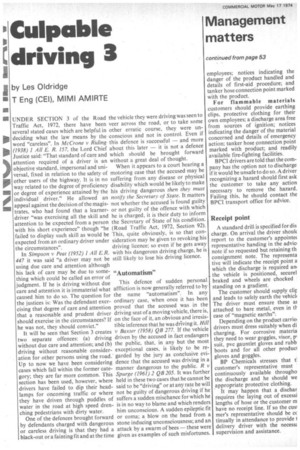Culpable driving 3
Page 58

If you've noticed an error in this article please click here to report it so we can fix it.
by Les Oldridge T Eng (CEI), MIMI AMIRTE
UNDER SECTION 3 of the Road Traffic Act, 1972, there have been several stated cases which are helpful in deciding what the law means by the word "careless". In McCrone v Riding (1938) 1 All E. R. 157, the Lord Chief Justice said: "That standard of care and attention required of a driver is •an objective standard, impersonal and universal, fixed in relation to the safety of other users of the highway. It is in no way related to the degree of proficiency or degree of experience attained by the individual driver." He allowed an appeal against the decision of the magistrates, who had found that a learnerdriver "was exercising all the skill and attention to be expected from a person with his short experience" though "he failed to display such skill as would be expected from an ordinary driver under the circumstances".
In Simpson v Peat (1952) 1 All ER. 447 it was said "a driver may not be using due care and attention although his lack of care may be due to something which could be called an error of judgment. If he is driving without due care and attention it is immaterial what caused him to do so. The question for the justices is: Was the defendant exercising that degree of care and attention that a reasonable and prudent driver should exercise in the circumstances? If he was not, they should convict."
It will be seen that Section 3 creates two separate offences: (a) driving without due care and attention; and (b) driving without reasonable consideration for other persons using the road.' Up to now we have been considering cases which fall within the former category; they are far more common. This section has been used, however, where drivers have failed to dip their headlamps for oncoming traffic or where they have driven through puddles of water in the road at high speed drenching pedestrians with dirty water.
One of the defences brought forward by defendants charged with dangerous or careless driving is that they had a black-out or a fainting fit and at the time the vehicle they were driving was seen to veer across the road, or to take some other erratic course, they were unconscious and not in control. Even if this defence is successful — and more about this later — it is not a defence which should be brought forward without a great deal of thought.
When it appears to a court hearing a motoring case that the accused may be suffering from any disease or physical disability which would be likely to make his driving dangerous then they must notify the Secretary of State. It matters not whether the accused .is found guilty or not guilty of the offence with which he is charged, it is their duty to inform the Secretary of State of his condition. (Road Traffic Act, 1972, Section 92). This, quite obviously, is so that consideration may be given to revoking his driving licence; so even if he gets away with his dangerous driving charge, he is still likely to lose his driving licence.
"Automatism"
This defence of sudden personal affliction is now generally referred to by the name "automatism". In any ordinary case, when once it has been proved that the accused was in the driving seat of a moving vehicle, there is, on the face of it, an obvious and irresistible inference that he was driving it. Hill v Baxter (1958) QB 277. If the vehicle driven by the accused in fact endangers the public, that, in any but the most exceptional cases, is likely to be regarded by the jury as conclusive evidence that the accused was driving in a manner dangerous to the public. R Spurge (1961) 2 QB 205. It was further held in these two cases that he cannot be said to be "driving" or at any rate he will not be guilty of dangerous driving if he suffers a sudden mischance for which he is in no way to blame and which renders him unconscious. A sudden epileptic fit or coma; a blow on the head from a stone inducing unconsciousness; and an attack by a swarm of bees — these were given as examples of such misfortunes.








































































































